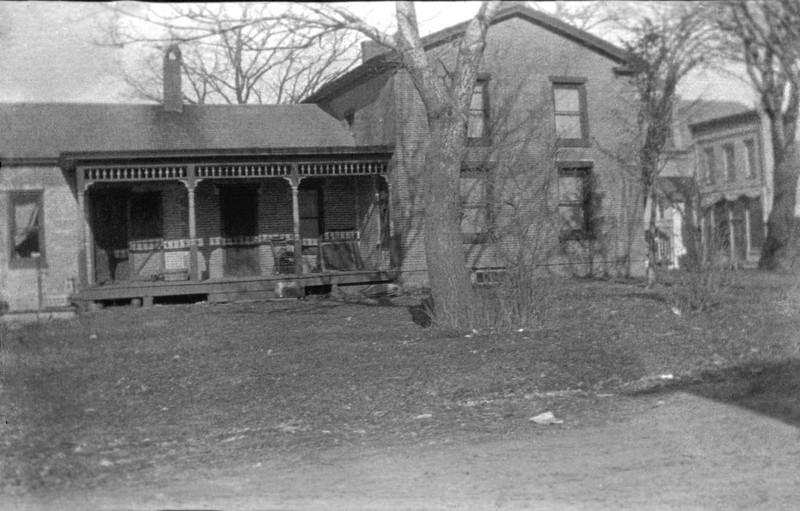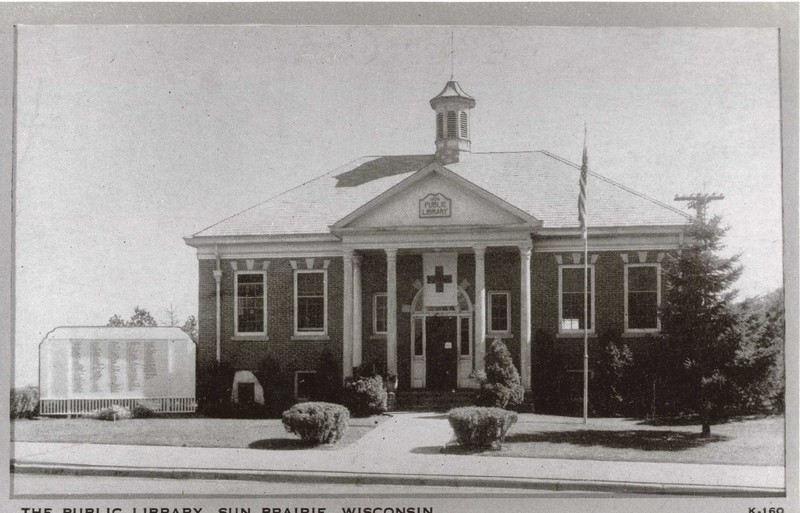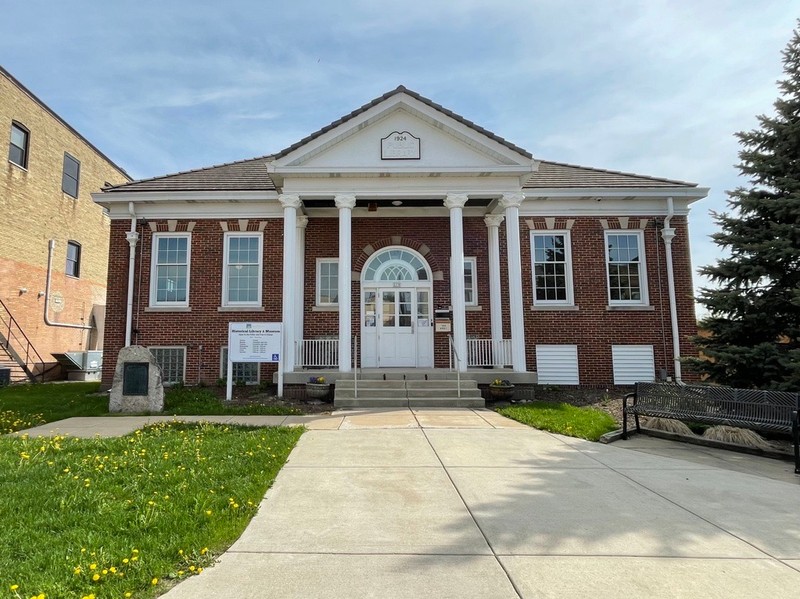First Homesite in Sun Prairie
Introduction
Text-to-speech Audio
Start your tour outside of the Sun Prairie Historical Library and Museum.
This location was the original homesite of Charles and Lovina Bird, the area’s first settlers of European descent. Charles was a member of the group led by his brother, Augustus Bird, charged with building the capitol in Madison, that passed through and named Sun Prairie in 1837. “After nine weary days of rain they were thrilled with sunshine upon this prairie and carved “Sun Prairie” on a burr oak tree one mile and a half east of this village.” Charles returned to Sun Prairie in 1839 and built a wood frame home that was replaced in the 1850s by a brick house. The home passed to his daughter Ada Bird, an internationally acclaimed pianist credited with starting the University of Wisconsin-Madison School of Music. After Ada’s death, the property was donated to the village for use as a public library. In 1924 the Bird's house structure was replaced by the current building, designed by Alvan Small and built by Frank Stegerwald, Sr. as Sun Prairie's first standalone library.
The Historical Library and Museum is one of 26 buildings in the Sun Prairie Downtown Historic District, spanning 100 to 245 East Main Street, that were constructed between 1862 and 1958. The District was added to the National Register of Historic Places in 2019.
Scroll down for more detail on this building.
Images
Home of Charles H. Bird, ca. 1900. SPHLM #N1111

Sun Prairie Public Library, ca. 1926. SPHLM #P00151a

Sun Prairie Public Library with Red Cross flag, ca. 1940s. SPHLM #N754A

Sun Prairie Historical Library & Museum, May 2023

Backstory and Context
Text-to-speech Audio
115 E. Main
Historic Name: Sun Prairie Public Library
Constructed: 1924
2024 Business: Sun Prairie Historical Library & Museum
The City of Sun Prairie traces its roots to 1837 when the Augustus Bird Expedition passed through on its way to Madison to construct buildings for the new territorial capital. After days of rainy travel, the group arrived at a sun-soaked prairie and carved “Sun Prairie” on a burr oak tree.
As a member of the capitol founding group, Charles H. Bird spent his first years working with his brother on the construction of Madison and operating the “Madison Hotel.” After he met and married Lovina Brayton they chose to make their own home in the Sun Prairie area in 1839, at the junction of what later became the Watertown (now Hwy 19), Bristol (now Hwy N) and Columbus (now Hwy 151) roads – once known as Bird’s Corner. The Birds were the first settlers to reside in the area and built a wood framed home on the site – legend has it on the same spot that the capitol build team first camped when discovering and naming Sun Prairie. Visualizing the area as it existed when surveyed in 1840, an “oak opening” – described as a “park-like area studded with burr oaks, interspersed with occasional white or Black oaks that had escaped the frequent prairie fire flames, all carpeted with deep grass” – covered the hillside as it rose up to the current location of the Sun Prairie Water Tower. A small stream flowed from north to south by their home, passing Main St. where the Old City Hall is located. The stream drained from a small pond to the north down to the marsh that still exists below the current railroad tracks and behind Sun Prairie East High School. A group of Ho-Chunk people occupying wigwams near the current site of the Water Tower were the Birds' only neighbors when they first established their homestead.
Through the 1840s, as other settlers arrived, the Bird home became the social center of an emerging community that was formally organized as the town of Sun Prairie in 1846. In addition to farming, Charles was a merchant, the local Justice of the Peace and by the early 1850s had constructed a 2-story brick home on the site. Charles and Lovina had four sons prior to her death in 1852, all of whom served with Wisconsin regiments in the Civil War. Charles Bird would later remarry to Margaret Hayden and had a daughter, Ada, from that marriage. Ada Bird was an internationally acclaimed pianist and is credited with starting the School of Music at the University of Wisconsin.
Charles and Margaret continued to live in the house until Charles’ death in 1883, after which Margaret took up residence with Ada in Madison. When Ada passed unexpectedly in 1914, the house passed to her friend, Elizabeth Veerhusen Kind (Mrs. John Kind), who donated the house to the Village of Sun Prairie in 1923 with the purpose of making it a public library in memory of the Bird family. Upon close inspection, however, significant deterioration of the brick, hand-hewed pine underpinning and sills was found, and it was determined that renovating the existing structure would have been too costly an option to pursue. Consequently, with the consent of Mrs. Kind and members of the Bird family, the original house was razed and the current red brick building, designed by architect Alvan E. Small and built by Frank Stegerwald, Sr., was constructed as Sun Prairie’s first dedicated library building. In addition to housing the library, the building was used for local government offices, a community meeting place, and the only public women's restroom downtown for its first years. The building’s basement served as a Red Cross center during World War II.
The public library relocated in 1967 and the building became the Sun Prairie Historical Library & Museum.
Sources
Klein, Peter Michael. Sun Prairie's People - Shadows and Dreams. Sun Prairie, WI. Sun Prairie Historical Museum, 1993.
Hayden, Estelle, and Nora Noyes Philpot, et.al. Early History of Sun Prairie, scrapbook by the (Sun Prairie) Twentieth Century Club, 1935.
Bridgeman, Michael. Alvan Small, Architect | Part 2: Designs for Education and Business. Madison Trust for Historic Preservation, August 31, 2021
https://www.madisonpreservation.org/blog/2021/8/31/alvan-small-architect-part-2-designs-for-education-and-business
Sun Prairie Historical Library & Museum
Sun Prairie Historical Library & Museum
Sun Prairie Historical Library & Museum
Sun Prairie Historical Library & Museum
